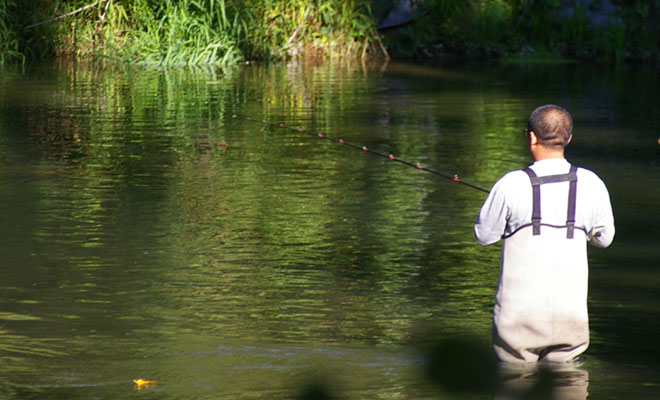
By Terry W. Sheely
Eight hundred and eighteen years ago, the poet politician and English lit major Geoffrey Chaucer almost declared that, “All roads in Juneau lead to fishing.”
Almost.
A little critical verbiage seems to have been lost in the Latin-to-Alaskan translation of, mille vie ducunt hominem per secula Romam, “a thousand roads lead man forever towards Rome,” long since abbreviated to, “all roads lead to Rome.” Which is an inexcusably verbose decoding of Chaucer’s maxim and woefully lacking in pertinent fish references.
But not in Juneau. Here all 41 miles of Egan Drive, the capital city’s north-south arterial between Thane and Echo Cove, lead to fish: saltwater and freshwater, creeks and beaches; kings, coho, chum, pinks, Dolly Varden, rainbows, cutthroat and sometimes steelhead.
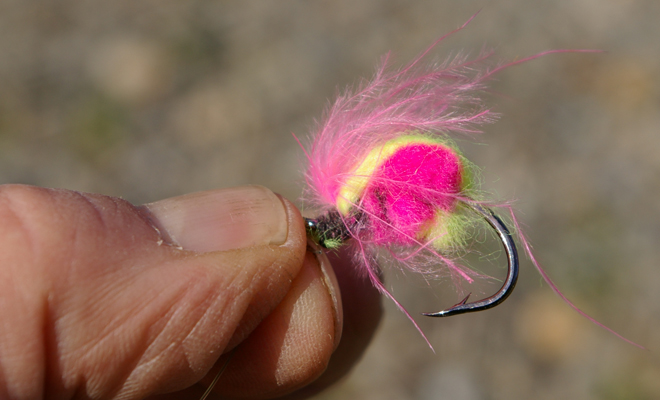
You’ll need several of these little babies, which attract chum, pink and silver salmon. © Terry Sheely
In this city of bureaucrats, tourists and fishermen the guy in the ditch along the road may, like Chaucer, be a politician looking for votes, or a misadventuring cruise ship escapee, but more likely he’s an enlightened angler fixated on a trout dimple or salmon swirl.
Juneau’s April to October fishing action is an unusual urban advantage, even here in Alaska where some cities brag about a month or so of good seasonal fishing in the home river, or shoulder into the fame of a nearby or distant destination.
In Juneau, good fishing water is, with apology to author Tom Robbins, another lusty roadside attraction where the biggest hazard to fly fishermen isn’t surprising a short-tempered brown bear, but sinking a backcast into a passing mini-van. Small boaters tow headless herring past the fried chicken at Lena Cove Picnic Area. Unrepentant spinners straddle algae-greased rocks within sight of the SOB (State Office Building), and put Pixie hooks into prime gamefish in Gastineau Channel.
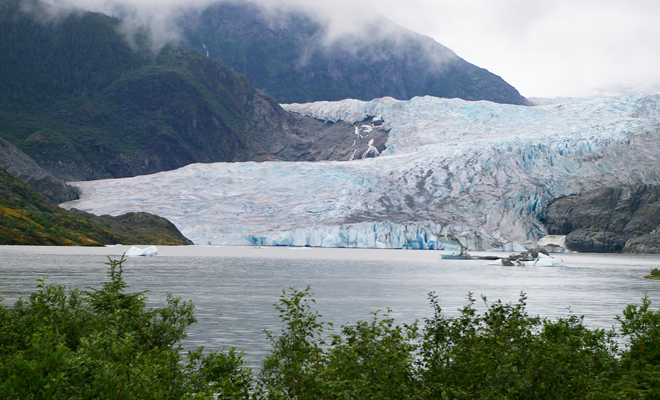
Mendenhall Glacier. © Terry Sheely
Juneau’s roadside rod action offers rare opportunity to ride Capital Transit to the current honey hole, and what the tire hum of urban angling lacks in aesthetics it replaces with convenience and productivity. Where else can you see a sport-jacket and slacks carrying a brace of salmon and a canvas tackle bag up the sidewalk towards the Express Bus stop on Willoughby Avenue?
Simply put: A lot of exceptional fishing waits on the roadsides in Juneau.
Fish Creek, Sheep Creek, Amalgam Harbor, Cowee Creek, Montana Creek, Eagle Beach, Bridge Cove, Gastineau Channel—just some of the small but prominent spots where from April through October anglers find fish.
Chris Casey, retail manager at Juneau Flyfishing Goods down on South Franklin Street, and a sometimes fish guide, loves the idea of sticking trout and salmon from the black top of the state capital. For him, it’s a busman’s holiday because paid guiding is not allowed in the 3,255 square miles that make the Borough of Juneau the second largest municipality, by area, in the U.S.
At 8 on a drizzly gray morning, fishing buddy Jim Goerg and I meet Chris at the Prospector Motel, climb into his SUV and set off to discover Juneau’s front yard fishing.Chris runs down a lexicon of close-in options for salmon, sea-run cutthroat and Dolly Varden fishing in streams that filter into Auke Bay, Gastineau Channel and Douglas Island. We leave downtown, cross Gastineau Channel Bridge to Douglas Island, and turn right onto North Douglas Hwy. all 9 miles of it.
The road hugs the shoreline and shows an occasional bank fisherman. We stop briefly at a pretty little tumble of a stream called Fish Creek to check from the bridge for salmon. We’ll fish here, later, after Chris shows us Outer Point at the end of the highway. The point splits Auke Bay and Stephens Pass, has a good boat ramp and when DIPAC kings come in supports a hugely popular bank-casting and kicker boat fishery.
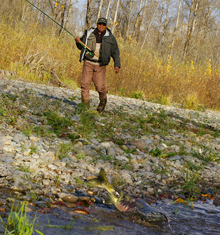
Landing a chum. © Terry Sheely
DIPAC is an acronym for Douglas Island Pink And Chum, an enhancement program that has elevated Juneau’s historically intermittent king and chum salmon fisheries from outside bets to predictable sure things.
Upwards of 126 million juvenile DIPAC salmon are stocked into Gastineau Channel and nearby waters through the Macaulay and Snettisham Salmon Hatcheries, including a million kings, 108 million chum and half-a-million silvers. The kings and silvers are earmarked for sport fishermen. Anglers and commercial netters share the chum, pinks and sockeye, but there’s plenty of fish—especially the big dogs—for sport anglers to target. Sockeye, which support most of the commercial netting, are released almost exclusively from the Snettisham facility south of Juneau.
When the adult kings, chum and silvers from the Macaulay releases return, beginning with big numbers of hatchery kings in late June after the weak runs of wild Chinook have passed, it triggers an epidemic of salmon fever that sweeps the town. They attract a wall of hip-booted anglers to the rock and rip rap on the edges of the shallow saltwater channel between downtown and Douglas, push into several urban creeks, crowd the city fishing dock at Macaulay, and salt the local saltwater with silver to support one of Southeast’s biggest salmon derbies.
Of all the angling options Jim and I find on our Juneau junkets, the most compelling is the exceptionally productive spring Chinook catch-and-keep fishery, but while this DIPAC fishery hogs the center-stage spotlight, there’s a lot more angling action to be discovered in the creeks and beaches around the edges.
Decent angling catches actually start in late March, early April and May with chunky Dolly Varden and steelhead cruising the waterfront and stacking up off Sheep Creek, Auke Bay and along the shallow edges of Gastineau Channel. It ends sometime in late October when cold winter rains freeze out the last of the coho and Dolly fishing.
Juneau resident and a frequent fishing companion John Beiler has helped fill in the roadside blanks for us.
“After our natural (wild) spring Chinook run passes through in May and early June, these (DIPAC) enhancement fish start returning to Auke Bay. When the catch rate from the creel census indicates a sufficient number of hatchery fish present, ADF&G (Alaska Dept. of Fish and Game) opens a terminal fishing area that includes Auke Bay, Fritz Cove and Gastineau Channel.
“Residents and non-residents alike can keep up to four kings a day in this area, and these fish do not count against the nonresident annual limit. I don’t know where else (in Alaska) a non-resident can keep four kings a day and it’s a rarity for residents.” According to John, the best part is that the DIPAC king harvest does not affect the natural Chinook runs. “The terminal area itself is awesome; Fritz Cove is great.”
The most productive Chinook areas are within easy range and reach of the kicker rental boats available at Auke Bay and Douglas Island, the banks of Gastineau Channel, and the city fishing pier.
“DIPAC hatchery kings,” John tells us, “were originally taken from local wild brood stock. They are grown to release size (two years) at Macaulay, and then shuttled off to net pens to imprint on the smell of Auke Creek and Fish Creek.”
In July, this juvenile imprinting leads the adult kings back to little Fish Creek, which is purling past our feet.
This Chinook fishery is a little different, Chris says, the kings don’t come in and anchor down, they move in and out of the creek on the tides. They may hold out in Gastineau Channel for two weeks, coming in and out of Fish Creek all that time, he says. In the lower end there’s a net pen and a wide spot known as “the pond,” a notorious snag fishery.
Back at the Fish Creek Bridge, Jim, Chris and I pull on waders, pick up fly and spinning rods and wade into the small tidal river, a large creek really, with log jams, riffles, narrow runs and shallow pools.
We fish downstream. Jim is out in front with a spinning rod; Chris and I following with fly rods, picking at pocket water and dark runs for silvers, pinks and Dollies. Big dead kings and crusty chum salmon drift in the pools. It’s tough to find the Dollies, and there’s no sign of silvers.
We catch pinks and dollies and see one big coho free jumping.
Wading and casting downstream in skinny Fish Creek, I can’t help but wonder what it must be like to hook 30 pounds of Chinook in this knee-deep water. “It’s pretty wild,” Chris says. “Lots of broken gear when those Chinook move into Fish Creek. It can get scary.”
Sounds perfect!
It’s a great morning to wade and cast to big fish on a small tidewater stream. Across the channel, a jetliner leans into the landing pattern at the international airport, and Mendenhall Glacier hides behind a bank of wet clouds. Just out of sight in the distance is the SOB, rows of trinket shops, book stores, offices, the Red Dog Saloon and the usual game of dodge ’em at the intersection of Ferry Way and Marine Way.
Down below me, tight to the blond strands of overhanging grass on the undercut bank, a king salmon rolls. I shake out a few extra feet of weight-forward line, run the hook file over the point on my pink-and-white Clouser and start the stalk.
The roadsides of Juneau aren’t technical fishing. A 9-foot spinning rod with 12-pound line on a reel with a decent drag system works just fine. Big spoons, flashy spinners, embarrassingly pink or hot green and pearlescent Buzz Bombs work as well as plug-cut herring floated under a tennis-ball size bobber or trolled. You’ll be at a disadvantage for coho, pink, and chum if you show up along the downtown waterfront without a box of Pixees, some with red yarn spiked on the hook.
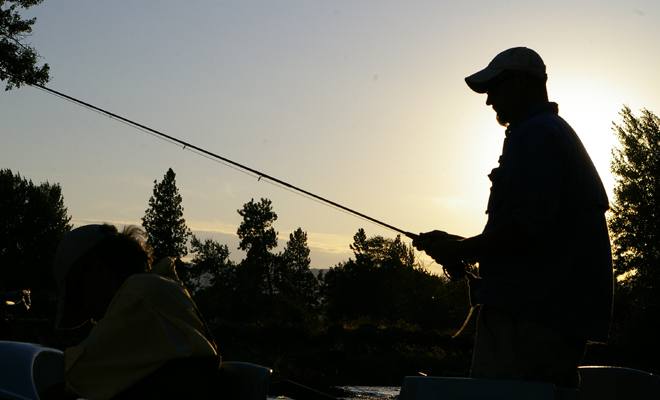
Fly Fisher. © Terry Sheely
Fly guys can handle anything salmon with 7- to 10-weight, floating or sink tip line, short, tough leader-tippet and a reel that can scream without freezing. Trout and Dolly Varden are no problem on 4- to 6-weights and you’ll be fishing in just a couple of feet of water so don’t bother with the heavy sinking lines. Kings and silvers favor big, snaky streamers, pinks like pink and green egg patterns, and the Dollies and trout will eat the entrée du jour, whatever is available—eggs during the salmon spawns, and in the spring alevin and small streamers that resemble salmon fry. Everything eats purple Egg-sucking Leeches. Don’t waste god fishing time on jaunty little dries.
These roadside fish eat fish.
If this rolling king doesn’t work out I have other options.
The hot spots for Juneau’s roadside rod attractions follow the calendar and from July into fall it’s not unusual to find the bigger creeks simultaneously flush with several species; kings, silvers, chum, pinks, and of course the ever-opportunistic Dollies.
Spring fishing can start with a very few steelhead in a very few streams, which for ethical reasons I’d prefer you discover on your own. The beaches, however, are the honey holes of April and May when Dollies, rainbows and sea-run cutthroat gather in the mouths and on the gravelly aprons, sometimes in bare inches of water, facing salmon spawning streams that spit buffets of salmon fry and alevin into the salt.
If you want to tickle trout in freshwater, away from the salt, you’ll want to park somewhere along the upper reaches of Fish Creek, Peterson Creek, Montana Creek or Cowee Creek.
Brad Elfers, guide and owner of Juneau Flyfishing Goods, is an avid roadside angler who stays on top of what’s hot and what’s not.
These are the top picks he gave me for the best of Juneau waters and when to fish them.
April: Dolly fishing along beaches picks up. Gastineau Channel is best along with Sheep Creek and Auke Bay. Baitfish flies and lures. Steelhead run starts in late April. Runs are small, less than 200 fish in most runs.
May: Dolly fishing remains good. Same spots. Steelhead peak first two weeks of May. Beach Chinook fishery at False Outer Point is hot enough to attract “combat fishery.”
June: Still good Dollies along shoreline until mid-June. Hatchery kings returning to Macaulay Hatchery, Auke Bay, and Fish Creek. In the last week of June, pink salmon show up in Echo Cove then move to other inlet areas.
July: Chum salmon start moving into Fish Creek, Sheep Creek, Amalgam Harbor, Cowee Creek, Macaulay DIPAC Hatchery. Just about any trickle of water will attract chum and pinks. In late July pinks start moving into these rivers, too. By late July, Dollies move in from the saltwater following the chum and pinks, feeding on spawned eggs.
August: More of the same: chum, pinks and Dollies. A few coho will be found off the beaches around Eagle Beach north to Bridge Cove.
September: Coho run starts around Labor Day in Montana and Cowee creeks, Gastineau Channel, Macaulay DIPAC Hatchery. Run peaks in late September. Dollies are spawning and still feeding on eggs.
October. Coho and Dolly fishery slows and heavy rains by mid-month usually wrap up the fishery for the year.
Terry W. Sheely is a contributing editor for Fish Alaska magazine.
The Roads ‘n Rods of Juneau originally appeared in the January 2010 issue of Fish Alaska.
